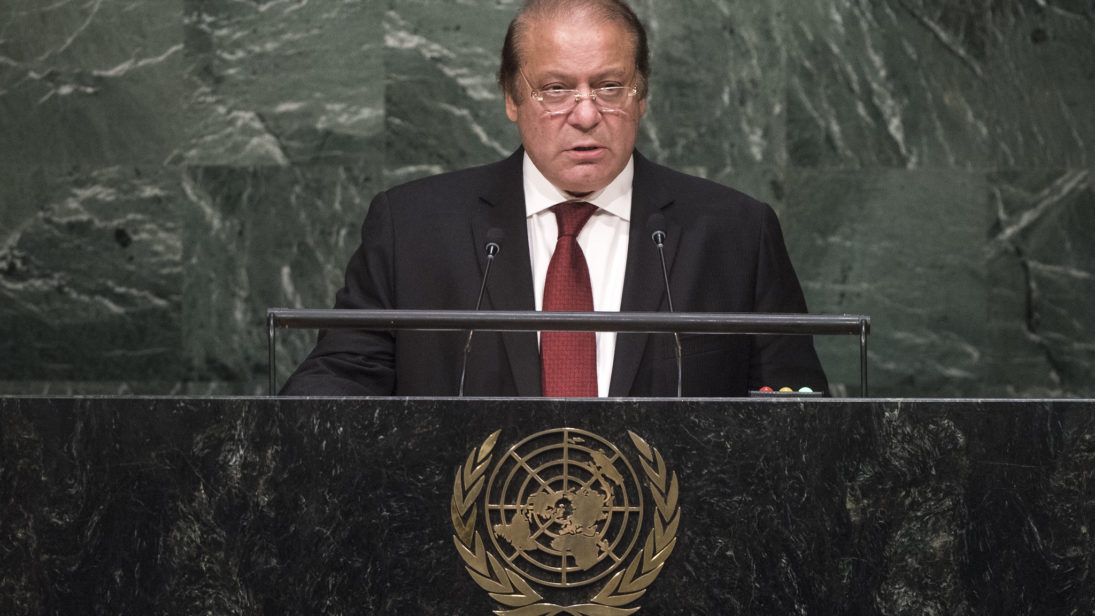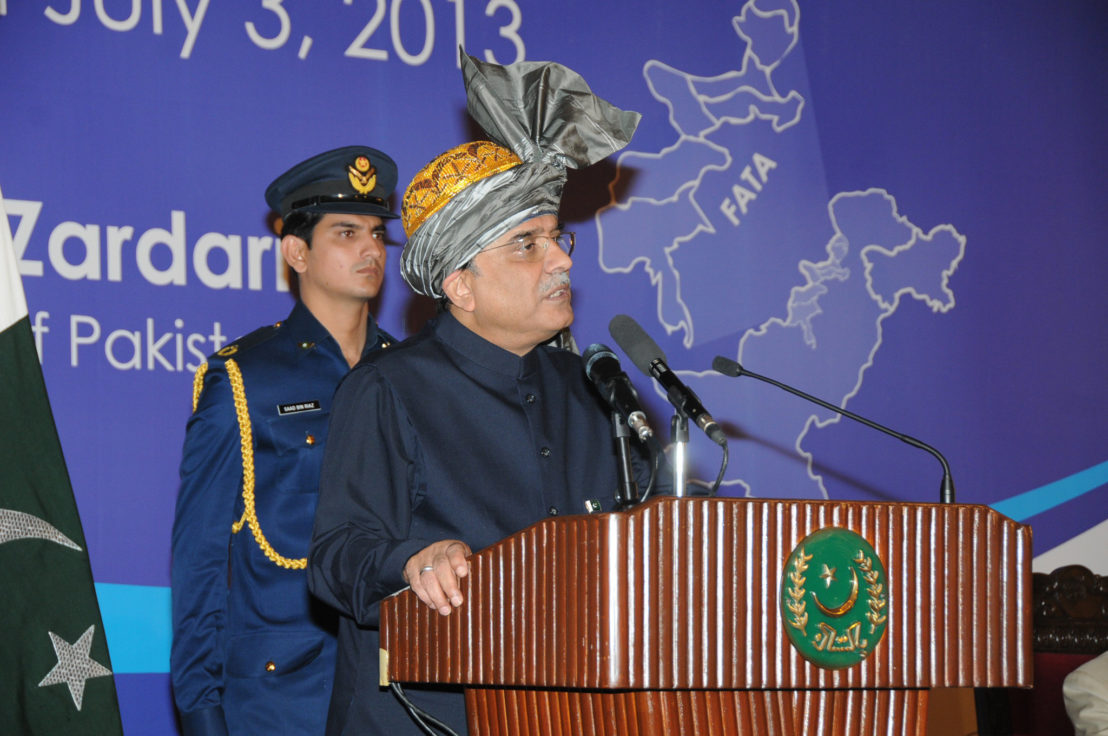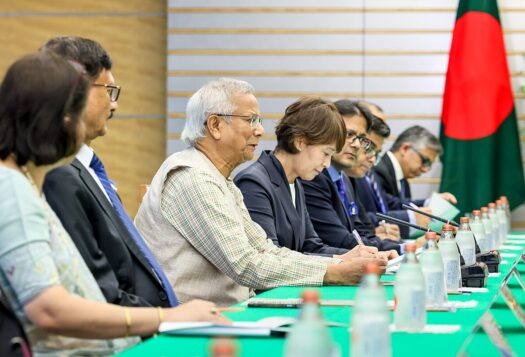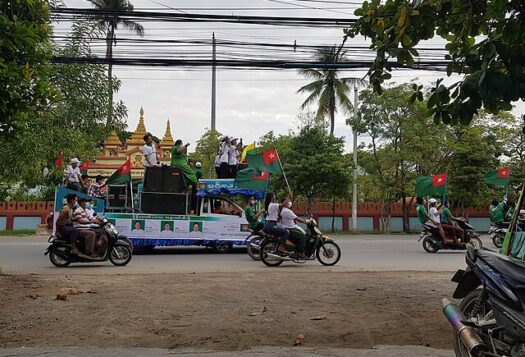
On Oct. 16, 2020, in a video address to a crowd organized by opposition parties, former prime minister Nawaz Sharif accused the security establishment of orchestrating his removal as Prime Minister in 2018 and installing the Pakistan Tehreek-e-Insaaf (PTI) government into power. Two weeks earlier, several major opposition parties formally launched the Pakistan Democratic Movement (PDM) as a unified effort against the PTI government and the involvement of the military establishment in politics. The PDM is a continuation of the multi-party conference, the opposition movement led by Pakistan Peoples Party (PPP) and Pakistan Muslim League-Nawaz (PML-N) that was announced in July 2020 and launched on Sept. 22. The PDM’s action plan is divided into separate phases and involves holding countrywide rallies leading to a “long march” in January 2021. The action plan will culminate in March ahead of the 2021 Senate elections.
The opposition announced that it would use all available tools, including no-confidence motions, to achieve its goals. The Jamiat Ulema-e-Islam-Fazl (JUI-F)’s President, Maulana Fazlur Rehman, had proposed resigning from parliament in June 2019 but the PPP and PML-N had both opposed the idea, maintaining that resignations were not a solution to national issues—leaving the Parliament would prevent both parties from pushing their stance effectively. Although the PML-N is now considering mass resignations in an effort to lend greater credence to Sharif’s defiance against the establishment, the PML-N alone will not be able to sustain the movement. Since the opposition parties have their own manifestos and political interests, and each seeks to remain relevant in the political process, this multi-party alliance might be unsuccessful like its predecessors.
Since the opposition parties have their own manifestos and political interests, and each seeks to remain relevant in the political process, this multi-party alliance might be unsuccessful like its predecessors.
Failure of Former Opposition Alliances
Even though political expediency has once again forced the PML-N and PPP to join hands, both sides remain wary of the others’ intentions. For example, in May 2019, both parties vowed to launch an agitation against the government on account of the growing inflation in the country. Ultimately, the PML-N and the PPP did not launch the protest and instead sought to remove Sadiq Sanjrani, the PTI’s chairman in the Senate. This move was the first step taken by the opposition to increase pressure on the PTI-led coalition government. Despite their combined majority, however, the two opposition parties were unable to remove the Senate Chairman.
In the aftermath of the failed vote, the PML-N accused the PPP of dubious activity to save PPP’s hold on Sindh. Mistrust emerged between the two sides soon after submitting the no-trust motion against Sanjrani. Ahead of the vote, the PML-N had sought clarification from the PPP over an alleged meeting between PPP leader and former President Asif Ali Zardari and a top property tycoon to discuss undermining the motion. The PPP refuted these reports. However, the events that led to the Chairman’s election to the Senate in March 2018, were reportedly part of the PPP’s plan to weaken the PML-N and “devised through political engineering and alliance building.”
Similarly, in October 2019, the PPP and the PML-N, together with the JUI-F, announced another agitation against the PTI government. Although the PPP and PML-N joined the initial Azadi march spearheaded by the JUI-F, they did not endorse the final sit-in, leaving Maulana Fazlur Rehman and his workers alone. Their decision can be attributed in part to Maulana Fazlur Rehman’s insistence to keep his plans secret and not share them with his alliance partners. Both the PPP and PML-N were not willing to participate in an indefinite sit-in. Notwithstanding the opposition’s decision to abandon the JUI-F’s sit-in, Maulana Fazlur Rehman was able to make himself relevant in Pakistani politics once again. Since the 1970s, Rehman has moved from one opposition alliance to the next, shaking hands with many unlikely partners in the process. For Rehman, the one constant is his madrassa-based support which enables him to “sustain his brand.” However, his constant swinging could easily mar the opposition’s efforts to establish a formidable front against the government.
Conflicting Party Interests
PML-N leaders remain wary of Zardari, given his past decision to undermine his commitment to PML-N to remove the Senate Chairman and forging an agreement with the civilian government instead to gain political mileage. The conflicting viewpoints are also an example of the numerous differences in opinion that exist between senior leaders of the party. Senior PPP leader Chaudhry Aitzaz Ahsan expressed his reservations about the alliance, warning his party to “be careful” in its dealings with PML-N.
The PML-N has taken a far tougher stance against the present regime as compared to the PPP which may be “keeping its options open.” In an effort to counterbalance the PML-N’s hold of the Senate, the PPP, PTI, and a bloc of independent senators from Balochistan, backed Sadiq Sanjrani in March 2018. However, the alliance did not last long. Problems first emerged between the PPP-led Sindh government and the PTI-led federal government in December 2018 when several PPP leaders including Zardari, his sister Faryal Talpur, and son Bilawal Bhutto-Zardari, were placed on the Exit Control List following the compilation of a report by the Supreme Court-mandated joint investigation team. Several PPP leaders are also facing serious allegations of corruption and have reportedly sought a deal with the establishment regarding their cases with the National Accountability Bureau (NAB).

A recent development has once again highlighted the fragility of the opposition’s alliance. In the aftermath of the PDM’s launch, PML-N stalwart Khawaja Asif said it was “difficult” for him to trust Zardari. The statement prompted PML-N Leader Mian Nawaz Sharif to issue a statement saying he had “a great deal of respect” for Zardari.
For the foreseeable future, the PDM will most likely remain ineffectual in bringing down the government or weakening the military’s role in politics. However, despite its limited ability to influence change, the PDM has managed to unnerve Khan’s government.
According to observers, this attempt by the opposition to oust Khan will once again not yield much. Given the differences in ideology and the end results each party seeks, “[the PDM] lacks a coherent purpose, outside of securing certain freedoms and privileges for the senior leaders of these parties.” Due to their conflicting interests and inability to reconcile them, the opposition has been unable to form a unified front against the government and party-centered interests seem to take precedence over the greater movement. The PDM has the potential to become a formidable force only if the opposition is willing to let go of its rhetoric and work towards their shared goals.
For the foreseeable future, the PDM will most likely remain ineffectual in bringing down the government or weakening the military’s role in politics. However, despite its limited ability to influence change, the PDM has managed to unnerve Khan’s government. Not only has the PTI government criticized Sharif for “defaming” the army, but Sharif has also been accused of trying to create political instability as the opposition continues to criticize the PTI for being a government that rose to power following rigged elections in 2018. According to reports, the government detained and arrested about 500 opposition figures and activists, most belonging to PML-N, ahead of the first PDM rally on Oct. 16. Muhammad Safdar, husband of Maryam Nawaz—Sharif’s daughter—and a leading figure in PML-N, was arrested on Oct. 19, a day after the second PDM rally was held in Karachi.
The PML-N’s position has been further compromised following the disclosure of a secret meeting between a senior PML-N leader and the Army Chief last month, an effort seen as an attempt to disrupt the PDM in its tracks. The PML-N’s interactions with the military, even as they criticize it for interfering in politics, erodes the legitimacy of their criticism. Additionally, in an effort to tighten the noose around the PPP, the NAB has issued an arrest warrant for PPP Chairperson Zardari. While criticizing the government, PPP Spokesperson Senator Mustafa Nawaz called the PTI government an authoritarian regime. He also chided the government for starting fake cases against opposition parties and leaders.
A Possible Overthrow of Government?
The growing public discontentment with the PTI government and its struggle to cope with multiple economic issues including unemployment and inflation—exacerbated by the global pandemic—might help the opposition movement succeed. The current round of opposition politics can also be seen as different given the defiant tone of PML-N’s Nawaz Sharif. Sharif’s Sept. 20 speech at the All Parties Conference expressed a clear indication that the “battle between Sharif and the establishment” has only just begun and his Oct. 16 speech further emphasized the growing tensions between PML-N and the military. It remains to be seen if opposition parties agree to set aside their personal agendas and work towards their common goal of overthrowing the Khan administration. Whether or not they will be able to gather enough support from the public will also decide the alliance’s eventual fate. Individually, the JUI-F has the ability to galvanize the public, but without sustained support from other parties, their efforts will be impaired. Similarly, Maryam Nawaz’s charisma and popularity can also mobilize the public, but the PML-N’s popularity could diminish if the public believes that Sharif’s actions are aimed at defaming the army or pursuing the agenda of Pakistan’s enemies.
***
Click here to read this article in Urdu.
Image 1:United Nations Photo via Flickr
Image 2: FATA Reforms via Flickr


